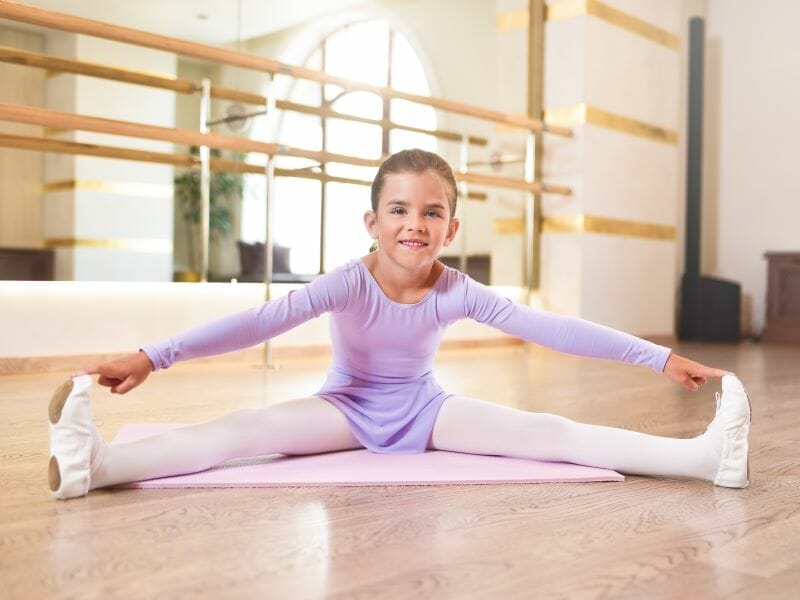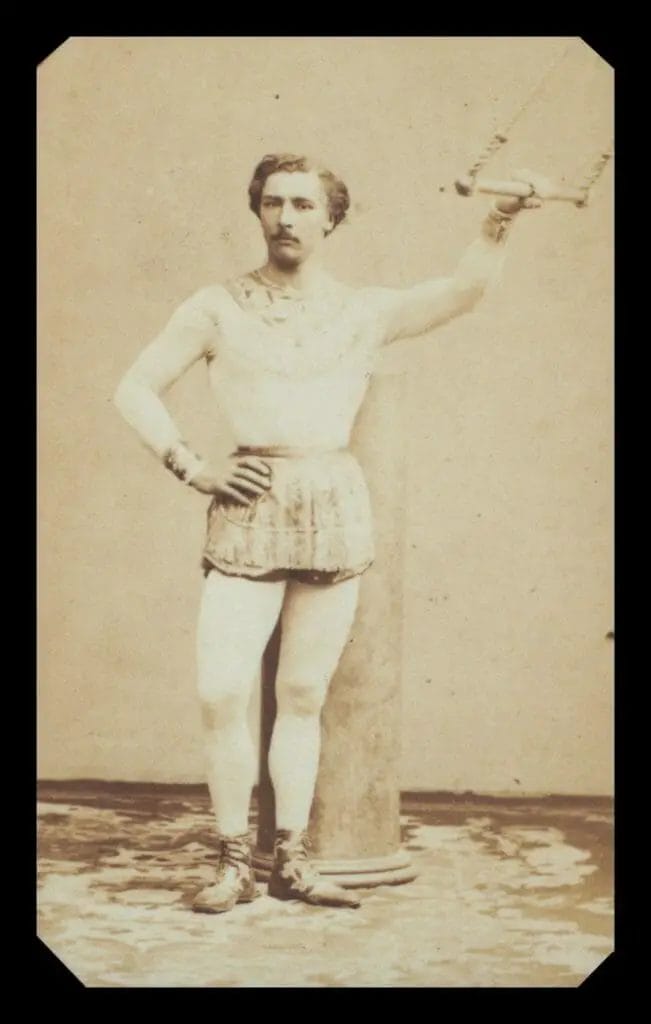Unitards and leotards are two different types of dance attire. Both are fitted, singular garments but cover different parts of the body.
It’s possible to wear them together, but you don’t necessarily need them both. Whether or not you need both depends on your personal preference or dance school requirements. Some dance schools insist on both as part of the required uniform.
Keep reading as we break down the differences, and then explore reasons for dress code requirements.

Unitard vs Leotard: What’s the Difference?
Both of these garments are form-fitting and made of thin fabric, but they each have different historical origins and unique properties.
Here’s more background information about each one to help us understand the difference between the two.
Early Athletic Use of the Unitard
Initially designed for men, the first version of the unitard was invented by Jules Leotard, who was a French acrobat artist.
Wearing these form-fitting garments has always been influenced by demonstrating the artist’s form and musculature. As an acrobat, Leotard invented the flying trapeze act in 1859.
He created what we now call the unitard and wore it during his performances in order for audience members to be able to see his figure and every move he made as he performed.
His unitard went down to about the mid-thigh area, and was cut low in the back. Sometimes he had thin shoulder straps, other times it was made with long sleeves and covered his legs.
Either way, uni, meaning one, resulted in one complete piece of attire that helped showcase athleticism.
The acrobatist actually referred to his unitard as a maillot, which referred to swimsuits in France. This is fitting because it’s been said that Leotard practiced his trapeze acts over his father’s swimming pool when he was solidifying his routines as seen in this picture of him as a child.
Initially only gymnasts and acrobats donned the unitard, which was made of wool or silk back in the late 19th century.
Early Dance Use of the Leotard
It wasn’t until the early 20th century that ballet dancers would wear leotards combined with tights during practice.
This was a huge advancement for ballet dancers. When practicing in leotards, they could move more freely with less cumbersome apparel.
Leotards actually weren’t named leotards until after Jules Leotard died of smallpox in 1870, at the young age of twenty-eight. Usage of the word leotard became more common around 1886.
There’s a vast history connected to the inception of leotards as we know them today. With so many details that I can hardly follow the timeline. Leotards have gone through lots of ups and downs, and they haven’t been exclusively worn in the dance industry.
With the advancement of textile fabrics, leotards became more stretchy and form-fitting. Leotards influenced women’s swimwear of the 1920’s and 1930’s. By the 1970s leotards were worn as a form of streetwear and were used by fitness instructors. Donna Karan helped to repopularize them as fashion wear during the 1980s. They became increasingly popular with dancewear companies, like Capezio, around this time as well.
Currently you can find leotards made of many different fabrics – cotton, nylon, spandex, lycra, polyester, even velvet. The fabrics are as vast as the dancers who wear the leotards.
Unitard vs Leotard: How Are They Used Today?
Wearing either the unitard or leotard supports the dancer because they’re able to wear apparel that doesn’t restrict their movements or conceal their form.
Modern Day Use of Unitards
By today’s definition, unitards, sometimes called bodysuits or catsuits as well, are singular garments that cover the torso and legs down to the ankles. Some are designed to stop at the calf or in the thigh area, similar to bike shorts.
Usually there are long sleeves, but unitards can be sleeveless or have short or capped sleeves.
In addition to dancers, you’ll likely see gymnasts, aerialists, figure skaters, and more athletes wear unitards to various degrees. For instance, the unitards that wrestler athletes wear are also called singlets.
Modern Day Use of Leotards
Leotards only cover the upper body. They may have short cap sleeves, long sleeves, or thin straps like a tank top. The cut around the thigh area can be high, or low.
Dancers might wear shorts over their leotards in order to avoid feeling uncomfortable if the leotards creep up.
Leotard designs have improved over time to incorporate more stretch, inhibit color runs when washing, and limit all the fasteners, like zippers, hooks, and so forth, used in the past. Now they’re much easier to pull on and off, and they aren’t made with painful and distracting fasteners.
Unitard vs Leotard: Should You Wear Both?
Whether or not you should wear both, really depends on one of two things: your preferences and how comfortable you feel in one or the other, or whether or not wearing both is part of your dance school uniform.
Reasons to Wear Both: Personal Preference
For example, if you are concerned about your leotards inching up as you dance, then you might want to wear a unitard underneath your leotards. This way, your bum is covered, and you don’t have to feel awkward.
Reasons to Wear Both: Dance School Uniform
If your dance school requires that you (or your child who’s in dance) wear both the leotard and unitard, it’s helpful to comply. It may seem like an unreasonable request, but the request is founded on sound principles.
Decorum and Instruction
Uniformity is a hallmark of ballet dance, particularly classical ballet. Before you can learn proper turns and hold precise positions, you must look the part. You wouldn’t wear tap shoes for ballroom dance lessons, nor would you wear jeans or an oversized t-shirt to ballet class.
Wearing close-fitting attire helps the dance instructor to more accurately direct your movements. If you’re wearing clothes that make it difficult to see the lines your limbs create, then it would be a challenge to help you improve as a dancer. When your unitard is the same color as your shoes, this offers the instructor a clearer image of the lines you’re creating with your body.
Just as you’re required to have your hair pulled back, and be otherwise well-groomed, you may also have to wear both leotards and unitards. Some dance schools assign a leotard color to each dance class level.
And with all dancers in the class wearing the same uniform, there’s less of a distraction amongst them. This means that dancers can simply focus on their choreography without drawing many (if any) comparisons between themselves and other dancers.
Mindset and Muscle Memory
Wearing the required uniform also reminds you of where you are and what you’re expected to do.
Your brain forms associations. As soon as you pull on your uniform, your mind and body automatically know that you’re expected to act in a disciplined manner. The prompting is, “It’s time to perform,” so to speak.
And your body is involuntarily activated. You may notice that it automatically transitions into the proper stance. Or, your core immediately contracts and lifts.
Scientists have also found that uniforms can be linked to feelings of pride. Wearing one can influence how you see yourself and your profession in general. You might form more positive emotions surrounding your dance lessons. It can also help you feel more connected to fellow ballet dancers.
Body Care
Similar to tights, the unitard can help keep muscles warm during ballet practice. This is especially true during colder months.
By keeping the muscles warm, the dancer’s movements remain fluid and graceful.
The dancer also isn’t distracted by the thoughts and feelings associated with being cold and stiff. If you’re cold but have to concentrate on dance moves, that feeling can create a distraction. And distractions can lead to missteps and forgotten choreography.
It may not seem as though a thin unitard can offer warmth and comfort, but you’d be surprised by the difference it makes.
Overall, dressing the part – whether in a leotard, unitard, or both – helps you take ownership of your role as a ballet dancer. It also helps your ballet teacher to better instruct you.





